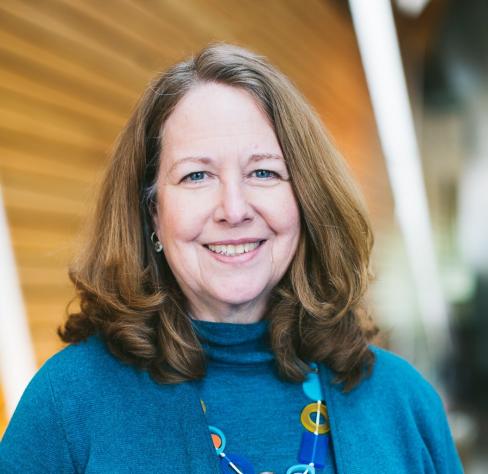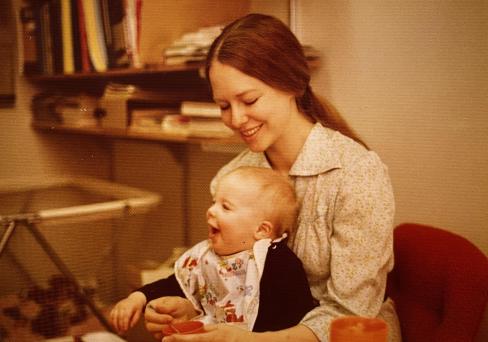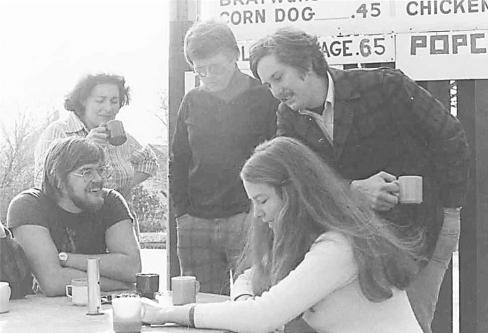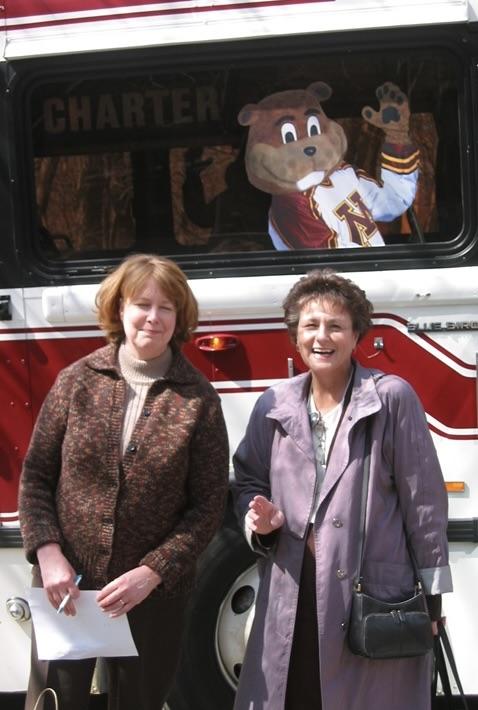Professor Emerita Becky Yust didn’t intend to pursue a career in academia. Originally set on becoming an interior designer, the advice and support she received from professors led her to pursue a career as an educator. During her time in higher education, Yust has served as a professor, program chair, department head, and even the College of Design’s interim dean. Over the course of her career, she’s mentored countless students, faculty members, and staff, helping them to find their own paths. After almost five decades of service, Yust celebrated her last semester at the University of Minnesota (UMN) in May 2022. In this interview, she reflects on her career, the challenges she faced, and shares advice for academics and designers.

Why did you decide to pursue a career in academia?
A career in academia was unforeseen, but that may ring false with my family. My younger sister and brother have vivid memories of sitting in our basement while I acted as teacher. However, rather than becoming a teacher, I decided I wanted to be an interior designer and enrolled at Colorado State University (CSU). During my senior year at CSU, a faculty member and I did some research projects and she asked if I had ever thought about going to graduate school. I had not, but applied and completed my master’s at CSU.
I was conducting research on color perception using the Munsell 100-hue test for my master’s thesis and a faculty member in the art department, Dave Yust, was curious about the project and he took the test for fun. His brother, John, visited that summer from St. Paul and Dave challenged him to take the test, too. John stopped by two days later to learn more about my research. Our relationship began, and six months later we were married and living in St. Paul. After moving to St. Paul, I planned to look for an interior design position. That never happened.

What brought you to the University of Minnesota?
As I was finishing my master’s, a UW–Stout faculty member called one of my CSU professors to ask if they knew someone who could teach because a faculty member was retiring. My professor realized that UW-Stout was not that far away from St. Paul and she encouraged me to apply. I interviewed for the position and started in January 1974. After three and a half years at Stout, there was an opening at the UMN in the Department of Family Social Science, College of Home Economics (CHE; later renamed the College of Human Ecology). I was hired as a tenure-track instructor but I knew that, if I was going to stay, I would need a doctorate.
I took a leave from the UMN and started the Ph.D. program at The Ohio State University in the fall of 1981 in the middle of a nationwide recession. A month before I was to start, I received a letter indicating that out-of-state tuition was increasing by 50%. I was committed to doing the degree, so my husband, John (who had just finished his master’s level architecture coursework at UMN) and our son, Chuck, moved to Columbus for the academic year.

I had declined a research assistantship because I needed time to complete all of my coursework credits during the required year of residency. However, by the end of fall quarter, the recession caused the building industry, and thus architecture, to slow down and John was laid off in January. We decided that it didn’t make sense for him to look for another job in Columbus, so he returned to St. Paul, and I accepted a research assistantship for the rest of the year. I returned to OSU for two more summers to complete my preliminary exams and the data analysis and defense of my dissertation.
The recession affected the UMN as well, and when I returned to St. Paul, I experienced my first major college reorganization. The UMN was exploring the possibility of the free-standing School of Social Work joining the Department of Family Social Science (it eventually joined CHE as a separate unit). My colleague and I felt that the department would be less aligned with our expertise and we asked Dean Keith McFarland if we could move to the Design Department which was slated to merge with the Department of Textiles and Clothing. The Department of Design, Housing, and Apparel (DHA) was formed in 1983. In 1995, many faculty accepted an enhanced retirement package (another recession) and I was offered the position of interim department head. After an internal search, I was appointed head of DHA and served until spring 2011.
What accomplishments are you most proud of from your career with the UMN?
I enjoyed all of the roles I had at the UMN and just tried to exceed expectations. I served as department head for 16 years and one accomplishment that comes to mind was the positive response DHA received to the extensive external review of our graduate program and research in the late 1990s. During the debriefing session, a reviewer said they could feel an esprit de corps among faculty in our program. I enjoyed that culture – people stepping up to the plate, working together, and honoring contributions – all while having fun.
I always saw my primary responsibility as an administrator was to help faculty and staff develop professionally. For tenure-track faculty, that meant helping them to establish research programs and teaching excellence to achieve promotion. For all staff and faculty, it meant assessing work portfolios and analyzing salaries to ensure we were competitive with other programs nationally and within the UMN. As Interim Dean in the College of Design (CDes), I worked with the Leadership and Talent Development unit of the Office of Human Resources to offer a year-long leadership development program for faculty in the college. Early cohort participants have become department heads, associate deans, and leaders in the college and across campus.

What were the greatest challenges you faced?
There were many challenges – typically focused on resources and people. When I became Interim Dean of CDes in 2015, I invited department heads, unit administrators, and CDes administrative leaders to a retreat focused on “managing up,” that is, how to manage and understand the relationship with one’s supervisor so that their own work can be successful. Because we were all responsible for the success of the units and the college, the relationships between people were crucial to that success. Additionally, I implemented a budget strategy for units to address new initiative investments simultaneously with their basic funding needs so that investments were integrated in creating the college budget.
What was your favorite class to teach?
I always enjoyed teaching housing studies courses because the content is based on the reality of people’s lives. After other housing faculty members retired, I picked up the Housing and Community Development course. The course required a community-engaged project that applied theories in the textbook to a neighborhood project in the Twin Cities. I have been involved with a non-profit community-based organization for more than 40 years, so the course was full-circle for me.
The second course I enjoyed was an honors seminar titled Housing Matters. The students came from a variety of majors – e.g., from neuroscience to computer science to marketing – and this was often the first time they learned about housing issues. The course examined the intersection of housing with health, educational attainment, economic opportunities, transportation, and the environment. It always was fascinating for me to read how the students linked housing issues with their diverse perspectives and that they were becoming housing advocates.

What’s been the biggest or most surprising change to higher education during your career?
I think the biggest change and greatest disappointment has been states’ diminishing investment in public higher education. I attended Colorado State for my bachelor's and master's, Ohio State for my Ph.D., and worked at the UMN, each of which is a land grant institution. As there was less state support, tuition increased. The percentage of the university budget provided by the state has decreased significantly and results in students’ greater financial burden to achieve their educational goals.
The other change is the evolution of technology that allows individuals the ability to work from anywhere and collaborate with others across the globe. It has increased productivity, but I think it has negatively affected the sense of collegial community among faculty across disciplines. Many were hired during the pandemic and being on Zoom was not the same as being physically present with one another. On the other hand, because of the pandemic, we all pivoted very quickly to provide instruction and conduct meetings online. A greater array of online courses provides flexibility for both students and faculty and it will be interesting to view continued changes.
What will you miss about working at the UMN?
The students. Responding to the changing student character keeps faculty dynamic. My goal was to keep students engaged in learning – that’s the common goal across the generations. I also will miss the intellectually stimulating spirit of campus faculty and staff.

What are your plans for retirement?
Nothing definite yet, I’ve been teaching for 48+ years, so my tether to the academic calendar will be disrupted and I’m looking forward to experiencing a different rhythm. I suspect more frequent travel is in my future as our oldest son and his family live in San Francisco, our daughter in Copenhagen, Denmark, and most of our relatives in Colorado. Also, John and I have lived in the same house since 1974, so there are some things we could get rid of! I did join the UM Retirees Association to keep informed about the UMN.
Any words of advice for current faculty members or design professionals?
My advice is to be comfortable with ambiguity, to be open to change to avoid undue stress, and to have fun!





